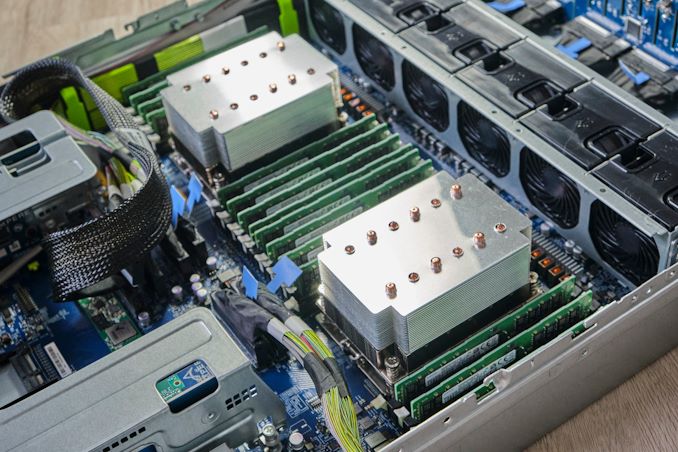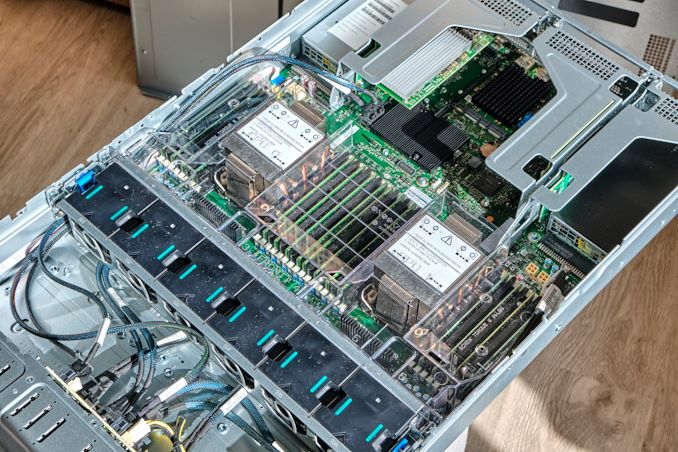The Ampere Altra Max Review: Pushing it to 128 Cores per Socket
by Andrei Frumusanu on October 7, 2021 8:00 AM EST- Posted in
- Servers
- Arm
- Neoverse N1
- Ampere
- Altra Max
Test Bed and Setup - Compiler Options
For the rest of our performance testing, we’re disclosing the details of the various test setups:
Ampere "Mount Jade" - Dual Altra Max M128-30 / Altra Q80-33
For the Ampere system, we’re still using our Mount Jade server, manufactured by Wiwynn, featuring Ampere’s Mount Jade DVT reference motherboard, testing both the Q80-33 and the new M128-30.
In terms of memory, we’re using the bundled 16 DIMMs of 32GB of Samsung DDR4-3200 for a total of 512GB, 256GB per socket.
| CPU | 2x Ampere Altra Max M128-30 (3.0 GHz, 128c, 16MB L3, 250W) 2x Ampere Altra Q80-33 (3.3 GHz, 80c, 32 MB L3, 250W) |
| RAM | 512 GB (16x32 GB) Samsung DDR4-3200 |
| Internal Disks | Samsung MZ-QLB960NE 960GB Samsung MZ-1LB960NE 960GB |
| Motherboard | Mount Jade DVT Reference Motherboard |
| PSU | 2000W (94%) |
We’re running an Ubuntu 21.04 server image – naturally because the system is Arm SBSA compatible, you’re able to boot off any compatible generic Linux distribution off of it.
The system has all relevant security mitigations activated, including SSBS (Speculative Store Bypass Safe) against Spectre variants.
The system has all relevant security mitigations activated against the various vulnerabilities.
AMD - Dual EPYC 7763 / 75F3 / 7443 / 7343 / 72F3
Our AMD platform for the Milan generation is a GIGABYTE’s MZ72-HB0 rev.3.0 board as the primary test platform for the EPYC 7763, 75F3, 7443, 7343 and 72F3. The system is running under full default settings, meaning performance or power determinism as configured by AMD in their default SKU fuse settings.
| CPU | 2x AMD EPYC 7763 (2.45-3.500 GHz, 64c, 256 MB L3, 280W) / 2x AMD EPYC 75F3 (3.20-4.000 GHz, 32c, 256 MB L3, 280W) / 2x AMD EPYC 7443 (2.85-4.000 GHz, 24c, 128 MB L3, 200W) / 2x AMD EPYC 7343 (3.20-3.900 GHz, 16c, 128 MB L3, 190W) / 2x AMD EPYC 72F3 (3.70-4.100 GHz, 8c, 256MB L3, 180W) |
| RAM | 512 GB (16x32 GB) Micron DDR4-3200 |
| Internal Disks | Crucial MX300 1TB |
| Motherboard | GIGABYTE MZ72-HB0 (rev. 3.0) |
| PSU | EVGA 1600 T2 (1600W) |
Software wise, we ran Ubuntu 20.10 images with the latest release 5.11 Linux kernel. Performance settings both on the OS as well on the BIOS were left to default settings, including such things as a regular Schedutil based frequency governor and the CPUs running performance determinism mode at their respective default TDPs unless otherwise indicated.
AMD - Dual EPYC 7713 / 7662
A few performance figures of the EPYC Milan 7713 and Rome 7762 parts were done on AMD’s Daytona system – unfortunately we no longer have access to these SKUs so this is why the differing platform.
| CPU | 2x AMD EPYC 7713 (2.00-3.365 GHz, 64c, 256 MB L3, 225W) / 2x AMD EPYC 7662 (2.00-3.300 GHz, 64c, 256 MB L3, 225W) |
| RAM | 512 GB (16x32 GB) Micron DDR4-3200 |
| Internal Disks | Varying |
| Motherboard | Daytona reference board: S5BQ |
| PSU | PWS-1200 |
AMD - Dual EPYC 7742
Our local AMD EPYC 7742 system is running on a SuperMicro H11DSI Rev 2.0.
| CPU | 2x AMD EPYC 7742 (2.25-3.4 GHz, 64c, 256 MB L3, 225W) |
| RAM | 512 GB (16x32 GB) Micron DDR4-3200 |
| Internal Disks | Crucial MX300 1TB |
| Motherboard | SuperMicro H11DSI0 |
| PSU | EVGA 1600 T2 (1600W) |
As an operating system we’re using Ubuntu 20.10 with no further optimisations. In terms of BIOS settings we’re using complete defaults, including retaining the default 225W TDP of the EPYC 7742’s, as well as leaving further CPU configurables to auto, except of NPS settings where it’s we explicitly state the configuration in the results.
The system has all relevant security mitigations activated against speculative store bypass and Spectre variants.
Intel - Dual Xeon Platinum 8380
For our new Ice Lake test system based on the Whiskey Lake platform, we’re using Intel’s SDP (Software Development Platform 2SW3SIL4Q, featuring a 2-socket Intel server board (Coyote Pass).
The system is an airflow optimised 2U rack unit with otherwise little fanfare.
Our review setup solely includes the new Intel Xeon 8380 with 40 cores, 2.3GHz base clock, 3.0GHz all-core boost, and 3.4GHz peak single core boost. That’s unusual about this part as noted in the intro, it’s running at a default 205W TDP which is above what we’ve seen from previous generation non-specialised Intel SKUs.
| CPU | 2x Intel Xeon Platinum 8380 (2.3-3.4 GHz, 40c, 60MB L3, 270W) |
| RAM | 512 GB (16x32 GB) SK Hynix DDR4-3200 |
| Internal Disks | Intel SSD P5510 7.68TB |
| Motherboard | Intel Coyote Pass (Server System S2W3SIL4Q) |
| PSU | 2x Platinum 2100W |
The system came with several SSDs including Optane SSD P5800X’s, however we ran our test suite on the P5510 – not that we’re I/O affected in our current benchmarks anyhow.
As per Intel guidance, we’re using the latest BIOS available with the 270 release microcode update.
Intel - Dual Xeon Platinum 8280
For the older Cascade Lake Intel system we’re also using a test-bench setup with the same SSD and OS image as on the EPYC 7742 system.
Because the Xeons only have 6-channel memory, their maximum capacity is limited to 384GB of the same Micron memory, running at a default 2933MHz to remain in-spec with the processor’s capabilities.
| CPU | 2x Intel Xeon Platinum 8280 (2.7-4.0 GHz, 28c, 38.5MB L3, 205W) |
| RAM | 384 GB (12x32 GB) Micron DDR4-3200 (Running at 2933MHz) |
| Internal Disks | Crucial MX300 1TB |
| Motherboard | ASRock EP2C621D12 WS |
| PSU | EVGA 1600 T2 (1600W) |
The Xeon system was similarly run on BIOS defaults on an ASRock EP2C621D12 WS with the latest firmware available.
Compiler Setup
For compiled tests, we’re using the release version of GCC 10.2. The toolchain was compiled from scratch on both the x86 systems as well as the Altra system. We’re using shared binaries with the system’s libc libraries.













60 Comments
View All Comments
Jurgen B - Thursday, October 7, 2021 - link
Love your thorough article and testing. This is some serious firing power from the Ampere and makes some great competition for Intel and AMD. I really like the 256T runs on the AMD Dual socket EPYCs (they really are serving me well in floating point research computing), but it seems that future holds some nice innovations in the field!mode_13h - Thursday, October 7, 2021 - link
Lack of cache seems to be a serious liability, though. For many, it'll be a deal breaker.Wilco1 - Friday, October 8, 2021 - link
Yet it still beats AMD's 7763 with its humongous 256MB L3 in all the multithreaded benchmarks. Sure, it would be even faster if it had a 64MB L3 cache, however it doesn't appear to be a serious liability. Doing more with far less silicon at a lower price (and power) is an interesting design point (and apparently one that cloud companies asked for).Jurgen B - Friday, October 8, 2021 - link
Yes, Cache will play a role for many. However, people buying such servers likely have a very specific workload in mind. And thus they now have more choices which of the manufacturer options they prefer, and these choices are really good to see. Compared to 10 years ago, when AMD was much less competitive, it is wonderful to see the innovation.schujj07 - Friday, October 8, 2021 - link
That isn't true at all. The SPEC java benchmarks have the Epyc ahead, SpecINT Base Rate-N Estimated they are almost equal (despite having half the cores), FP Base Rate-N Estimated the Epyc is ahead, compiling the Epyc is ahead. Anything that will tax the memory subsystem by not fitting into the small cache of the Altra and the performance is lower for the Altera. Per core performance isn't even close.mode_13h - Saturday, October 9, 2021 - link
Thanks for correcting the record, @schujj07.The whole concept of adding 60% more cores while halving cache is mighty suspicious. In the most charitable view, this is intended to micro-target specific applications with low memory bandwidth requirements. From a more cynical perspective, it's merely an exercise in specsmanship and maybe trying to gin up a few specific benchmark numbers.
Wilco1 - Saturday, October 9, 2021 - link
If you're that cynical one could equally claim that adding *more* cache is mighty suspicious and gaming benchmark numbers. Obviously nobody would spend a few hundred million on a chip just to game benchmarks. The fact is there is a market for chips with lots of cores. Half the SPEC subtests show huge gains from 60% extra cores despite the lower frequency and halved L3. So clearly there are lots of applications that benefit from more cores and don't need a huge L3.Wilco1 - Saturday, October 9, 2021 - link
The Altra Max wins the more useful critical-jOPS benchmark by over 30%. It also wins the LLVM compile test and SPECINT_rate by a few percent. The 7763 only wins SPECFP by 18% (not Altra's market) and max-jOPS by 13%.So yes my point is spot on, the small cache does not look at all like a serious liability. Per-core performance isn't interesting when comparing a huge SMT core with a tiny non-SMT core - you can simply double the number of cores to make up for SMT and still use half the area...
mode_13h - Saturday, October 9, 2021 - link
> Per-core performance isn't interesting when comparing ...Trying to change the subject? We didn't mention that. We were talking only about cache.
> The Altra Max wins the more useful critical-jOPS benchmark by over 30%.
That's really about QoS, which is a different story. Surely, relevant for some. I wonder if x86 CPUs would do better on that front with SMT disabled.
> the small cache does not look at all like a serious liability.
Of course it's a liability! It's just a very workload-dependent one. You need only note the cases where Max significantly underperforms, relative to its 80-core sibling, to see where the cache reduction is likely an issue.
The reason why there are so many different benchmarks is that you can't just seize on the aggregate numbers to tell the whole story.
mode_13h - Saturday, October 9, 2021 - link
Apologies, I now see where schujj07 mentioned per-core performance. I even searched for "per-core" but not "per core".